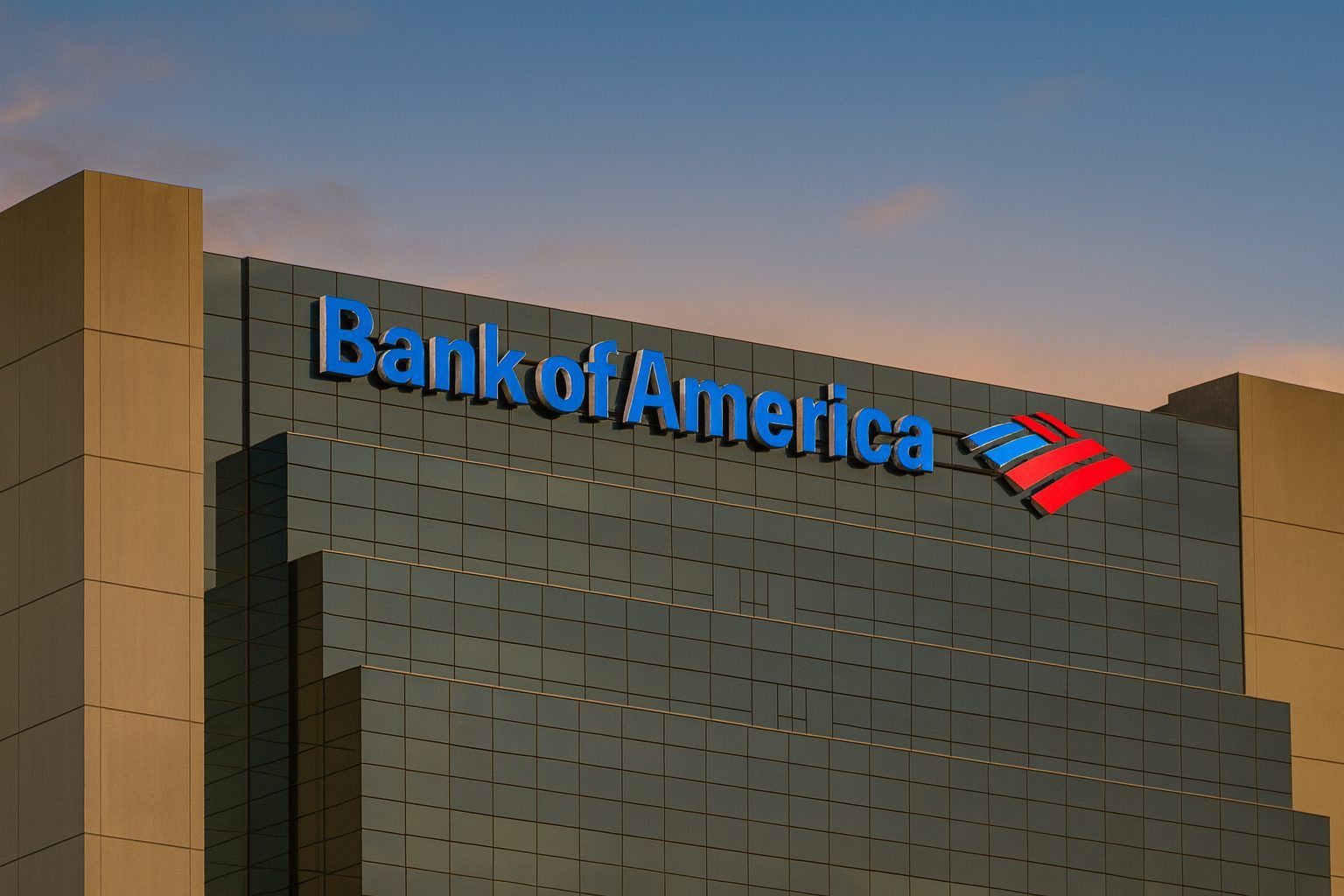Bank of America Corporation (NYSE: BAC) is trading close to its 52‑week high on Wednesday, November 26, 2025, as investors digest a mix of strong fundamentals, upbeat analyst research and a surprisingly cautious market outlook from the bank’s own strategists.
BAC stock price today and recent performance
By early afternoon U.S. trading, Bank of America shares are changing hands around $53, roughly 1% higher on the day, based on intraday quotes from MarketBeat, Barchart and other market data providers. [1]
- Pre‑market: BAC traded near $52.63, already up on heavy volume and ranking among Nasdaq’s most active names before the opening bell. [2]
- Intraday quotes: Around midday, MarketBeat showed BAC at $52.94 (+0.89%), while Barchart’s feed had the stock near $53.06 (+1.1%) later in the session, broadly in line with real‑time prices. [3]
Recent performance puts today’s move in context:
- 52‑week range: roughly $33.06 low to $54.69 high (set on November 12, 2025). [4]
- 3‑month gain: about +6.1% for BAC vs +2.8% for the Invesco KBW Bank ETF (KBWB). [5]
- 6‑month and 12‑month performance: BAC is up 21.5% over six months and 10.5% over 52 weeks, slightly outperforming the broader bank ETF over the same periods. [6]
- Year‑to‑date: Simply Wall St estimates BAC is up about 18.5% in 2025, aided by improving earnings and digital growth initiatives. [7]
With the stock now only a few percentage points below its recent high, today’s session is more about confirmation of the bull case than a dramatic re‑rating.
What’s moving Bank of America stock on November 26, 2025?
Several fresh headlines and research notes dated November 26, 2025 (and late on November 25, U.S. time) are shaping sentiment around BAC today.
1. BAC is outperforming other big bank stocks
A new analysis from Barchart, syndicated via StreetInsider, highlights that Bank of America has been outpacing the broader bank sector: [8]
- BAC is down only about 4% from its 52‑week high of $54.69, set on November 12.
- Over the last three months, BAC has gained 6.1%, versus 2.8% for the KBWB bank ETF.
- Over six months, BAC is up 21.5%, slightly ahead of KBWB’s 21% gain.
The article also revisits the bank’s third‑quarter 2025 earnings beat and notes that BAC has been trading above its 200‑day moving average since late May, supported by steady deposit growth and tight cost control. [9]
Wall Street sentiment in that piece is decidedly constructive: Barchart cites 26 analysts covering BAC with a consensus rating of “Strong Buy” and an average price target of $58.56—about 11–12% upside from current levels—with a Street‑high target of $70.
2. Zacks: rate cuts could favor BAC over Wells Fargo
A Zacks Analyst Blog post, republished on Nasdaq today, compares Bank of America and Wells Fargo in a world where interest rates are starting to fall.
Key points for BAC:
- Management has laid out a medium‑term plan targeting >12% annual earnings growth and a return on tangible common equity (ROTCE) of 16–18%, while keeping its CET1 capital ratio around 10.5%.
- Zacks expects BAC’s revenue to grow 7.2% in 2025 and 5.7% in 2026, with earnings rising 15.6% and 14.5% in those years.
- Net interest income (NII) is projected to grow 5–7% in 2026, helped by loan growth, deposit strength and repricing of fixed‑rate assets as funding costs ease.
While both BAC and WFC currently carry a Zacks Rank #3 (Hold), Zacks argues that Bank of America’s scale, digital strategy, and clearer earnings trajectory give it a better upside profile in a rate‑cut cycle.
This reinforces the narrative from Barchart: large‑cap bank exposure is increasingly being expressed via BAC, which helps explain why the stock is outperforming many peers.
3. BofA strategists turn cautious on U.S. stocks for 2026
Ironically, one of today’s most‑watched catalysts for BAC comes from Bank of America’s own research department, which has shifted to a more cautious stance on U.S. equities.
In a note summarized by Investing.com and based on Reuters reporting, BofA’s U.S. equity strategist Savita Subramanian now forecasts the S&P 500 at 7,100 in 2026, implying roughly 5% price returns from current levels.
Key takeaways from that call:
- Earnings are expected to grow about 14%, but valuation multiples could compress by around 10 points, limiting index‑level upside.
- Liquidity “tailwinds” are seen as fading—with fewer buybacks, more capital expenditures, and less aggressive central‑bank easing than in prior years.
- BofA expects a leadership shift in the market: “Capex > Consumption,” with a tilt toward defensive sectors like Staples and away from more cyclical Consumer Discretionary.
For BAC shareholders, this matters in two ways:
- Lower equity market returns could dampen risk appetite and weigh on bank stock valuations, potentially capping multiple expansion.
- A capex‑driven environment could still benefit BofA’s corporate lending, capital markets and cash‑management franchise—even if index returns moderate.
MarketBeat’s real‑time BAC news feed explicitly flags this cautious outlook as a negative sentiment driver for bank stocks, even as other research remains bullish on BAC itself.
4. New credit‑risk worries: prediction markets and sports gambling
Another angle that investors are watching today is BofA’s warning on consumer credit risks tied to the boom in sports betting and prediction markets.
- A Bloomberg‑reported note, picked up by multiple outlets, says Bank of America strategists see rapid growth in prediction markets and sports gambling as a new source of credit stress for lenders, as more consumers could take on excessive leverage and eventually fall behind on payments.
- A follow‑up piece from PYMNTS quotes BofA strategists describing “easy access and gamified interfaces” that encourage frequent, impulsive wagers and may “pressure credit quality, increase delinquencies, and impact earnings for issuers and subprime lenders.”
MarketBeat’s BAC dashboard highlights this as a potential negative for bank shares, noting that investors should monitor consumer loan performance and provisioning if gambling‑related risks begin to show up in credit metrics.
For Bank of America, which has a large U.S. consumer‑lending footprint, this theme is now firmly on the radar.
5. Corporate activity: 3% stake in Avadel Pharmaceuticals and other holdings
On the corporate side, Bank of America has appeared in fresh regulatory filings:
- Avadel Pharmaceuticals (AVDL): A new Irish Takeover Panel filing shows Bank of America has built a 3.006% interest in Avadel, including nearly 2.93 million shares and related cash‑settled derivatives, while also maintaining about 1.93% in short positions through securities and derivatives.
- PRS REIT: A separate disclosure reported by Investing.com indicates Bank of America has raised its stake in The PRS REIT PLC to 8.73% of voting rights.
These positions reflect activity within Bank of America’s capital markets, trading and prime brokerage businesses, rather than directional bets by retail banking operations. Still, they underscore how deeply embedded the firm is in global capital flows.
6. Big institutional investors reshuffle BAC positions
Today’s tape also reflects a series of institutional ownership updates, as reported by MarketBeat:
- The Employees Retirement System of Texas disclosed a new position of about 2.31 million BAC shares, worth roughly $109 million. BofA now makes up about 0.9% of the fund’s portfolio and is its 21st‑largest holding.
- A separate filing shows Segall Bryant & Hamill LLC cut its BAC holdings by 23.2%, selling 11,802 shares and ending the quarter with 39,087 shares valued at about $1.85 million.
- MarketBeat notes that, overall, institutional investors own around 70.7% of BAC’s shares, including large positions at Geode, Deutsche Bank, Amundi, Dimensional and Sumitomo Mitsui.
The mixed pattern—some large funds buying aggressively, others trimming—suggests active portfolio rotation rather than a one‑way exit or pile‑in.
Fundamental backdrop: Q3 2025 earnings beat
The strong tone behind BAC’s price action today is rooted in a very robust third‑quarter 2025 earnings report released on October 15.
Across multiple sources (SEC filings, Reuters, Zacks and independent analysis), key Q3 highlights include:
- Net income:$8.5 billion, up from $6.9 billion a year ago (roughly 23% growth).
- Earnings per share (EPS):$1.06, versus $0.81 a year earlier and well above consensus forecasts around $0.94–$0.95 (a ~12% beat).
- Revenue: About $28.09 billion, up roughly 10.8–11% year‑over‑year, and ahead of estimates near $27.3–$27.6 billion.
- Net interest income (NII): Around $15.2–$15.4 billion, roughly 9% higher than a year ago, driven by loan and deposit growth and solid balance‑sheet positioning.
- Efficiency ratio: Approximately 61.7%, better than analyst expectations near 62.8%, reflecting revenues growing faster than expenses.
- Tangible book value per share: About $28.39, up 7.6% year‑over‑year.
- Capital markets businesses: Investment‑banking fees rose around 43%, while markets revenue climbed 11% to about $6.2 billion, according to coverage in the Financial Times.
Management emphasized that every major line of business delivered top‑ and bottom‑line growth, with record net interest income and lower provisions for credit losses, supporting the case for higher dividends and buybacks.
For today’s trading, this Q3 backdrop is crucial: it helps investors look through the bank’s cautious macro commentary and focus on earnings power and efficiency gains.
Valuation, analyst sentiment and “fair value” debate
With BAC near $53, investors are debating whether the stock still offers attractive upside or is approaching full value.
Street valuation metrics
MarketBeat’s latest institutional‑ownership piece pegs Bank of America’s:
- Market cap: roughly $383 billion
- P/E ratio: about 14.3x trailing earnings
- P/E/G: around 2.0
- 12‑month low / high:$33.06 – $54.69
Barchart’s analysis similarly notes a market capitalization near $379 billion and highlights BAC’s trading premium versus some peers, but still within a typical range for a large, diversified U.S. bank.
Analyst targets
Across multiple sources:
- Barchart cites 26 analysts with a consensus “Strong Buy” rating and an average target of $58.56, with a high estimate of $70.
- MarketBeat’s round‑up of research calls shows a “Moderate Buy” consensus and an average target around $57.77, based on 23 Buy and 5 Hold ratings.
In other words, Street targets cluster in the high‑50s, implying low‑double‑digit upside if fundamentals and macro conditions evolve in line with current forecasts.
Simply Wall St: “about right” valuation
A fresh Simply Wall St note dated today frames BAC as roughly fairly valued after its strong year‑to‑date rally:
- The stock is quoted at $52.48 in that analysis, up 1.6% over the past week and 18.5% year‑to‑date.
- Using an “Excess Returns” valuation model, they estimate an intrinsic value of $56.47 per share, suggesting BAC trades at about a 7% discount—close enough to call “about right” given uncertainties.
- On a P/E basis, Simply Wall St finds BAC at about 13.6x earnings versus roughly 13.4x for peers and 11.4x for the broader banking industry, but notes that the bank’s growth profile could justify a modest premium.
Their conclusion: BAC’s current price largely reflects its fundamentals and outlook, with upside dependent on how investors interpret future narratives around growth, risk and AI‑driven efficiency.
Dividend and buybacks: income remains a key pillar
For income‑oriented investors, Bank of America’s dividend story is an important part of today’s thesis.
- In July 2025, the board raised the quarterly common dividend by 8% to $0.28 per share and authorized a $40 billion stock repurchase program, following strong results in the Federal Reserve’s stress tests.
- On October 23, 2025, BofA declared its fourth‑quarter 2025 dividend of $0.28 per share, payable December 26, 2025 to shareholders of record on December 5, 2025.
- Data from Koyfin indicates this translates to an annual dividend of $1.12 per share, an indicated yield around 2.1–2.2% at current prices, and a payout ratio near 32%, with 12 consecutive years of dividend increases.
That combination of growing dividends + large buybacks + robust capital ratios is one reason many analysts see BAC as a core long‑term holding in U.S. financials, even if near‑term total returns moderate.
Key risks and what to watch next for BAC stock
Even with the positive tone around earnings and shareholder returns, today’s news flow highlights several risks that BAC investors should keep on their radar:
- Macro and market‑valuation risk
- BofA’s own strategists are now projecting only “modest” S&P 500 returns (~5%) in 2026, driven by earnings growth but P/E multiple compression and fading liquidity tailwinds.
- If this view proves correct, bank stocks like BAC might see solid EPS growth but more limited multiple expansion, leading to milder total returns than in 2023–2024.
- Consumer credit quality, especially around gambling and prediction markets
- The bank’s warning that the gamification of trading and betting could increase delinquencies highlights a new behavioral risk for consumer lenders.
- Investors will be watching credit‑card charge‑offs, personal‑loan performance and reserve builds closely in upcoming quarters.
- Competition for deposits and funding
- Higher‑yield alternatives (money‑market funds, T‑bills, fintech platforms) continue to compete for customer cash. BAC’s ability to retain low‑cost deposits is critical for sustaining NII growth. Recent quarters have shown renewed deposit momentum, but that may be tested if the rate path surprises.
- Regulation and capital requirements
- While 2025’s stress‑test cycle was relatively benign and allowed for higher payouts, any future regulatory tightening—for example, around capital buffers or consumer protection—could constrain dividends and buybacks.
- Execution on digital and branch‑expansion strategy
- BAC is planning to open more than 150 new financial centers by 2027 and continues to invest heavily in digital platforms and AI‑enabled efficiency.
- The payoff from those investments—in terms of cross‑sell, cost saves and customer retention—will be a key driver of whether earnings can in fact compound at double‑digit rates.
Near‑term catalysts
Looking ahead from today’s session, BAC watchers will focus on:
- The ex‑dividend date on December 5, 2025, for the Q4 payout.
- Any updates to Bank of America’s macro and equity‑strategy outlook, especially if the economic data diverge from their “modest returns” baseline.
- Q4 2025 earnings, likely in mid‑January 2026, where the market will look for confirmation of NII growth, trading momentum and early signs of any credit‑quality deterioration.
Bottom line: BAC is strong, but expectations are higher too
On November 26, 2025, Bank of America stock is trading near its highs after:
- A blowout Q3 earnings beat,
- An 8% dividend increase and large buyback authorization, and
- A series of positive analyst assessments highlighting its scale, digital strategy and rate sensitivity.
At the same time, BofA’s own strategists are waving the yellow flag on U.S. equities and on behavioral risks linked to gambling and prediction markets—signals that the bank is acutely aware of the cycle’s late‑stage dynamics.
For investors, BAC increasingly looks like a high‑quality large‑cap bank priced close to fair value, with:
- Moderate upside to consensus price targets,
- A growing ~2%+ dividend, and
- Earnings that are still levered to loan growth, rate dynamics and capital‑markets activity.
References
1. www.marketbeat.com, 2. www.nasdaq.com, 3. www.marketbeat.com, 4. www.marketbeat.com, 5. markets.financialcontent.com, 6. markets.financialcontent.com, 7. simplywall.st, 8. markets.financialcontent.com, 9. markets.financialcontent.com







